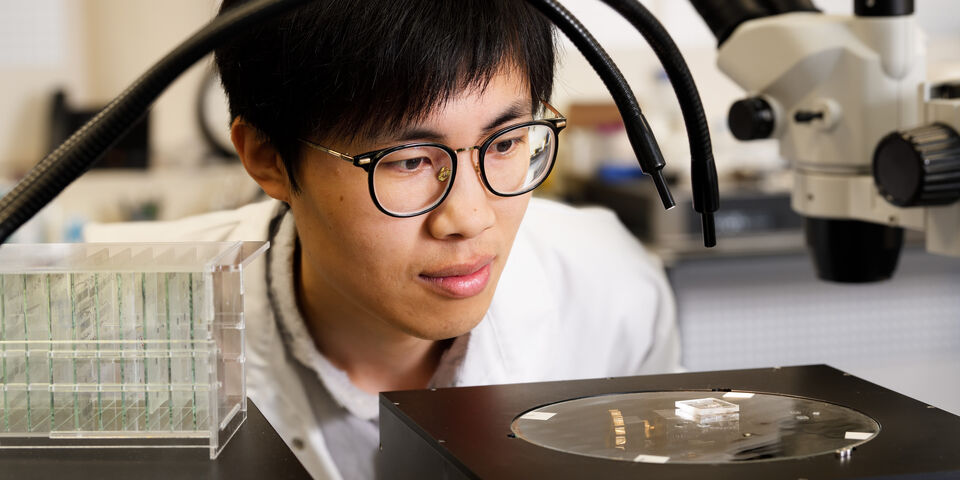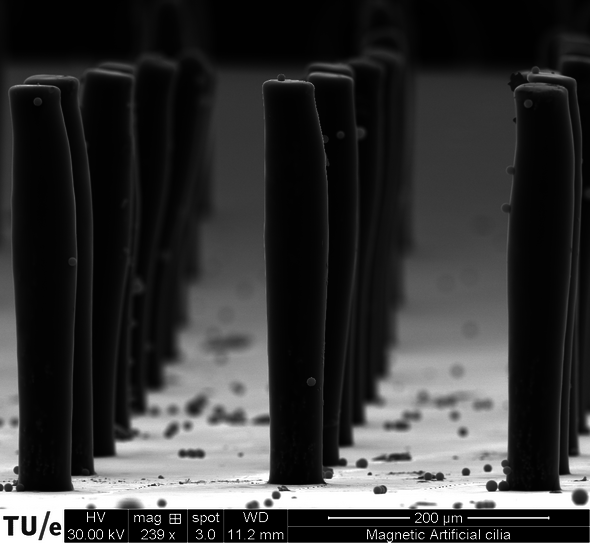Home Stretch | Magnetic hairs for mini lab
A ‘lab-on-a-chip’ is a portable laboratory the size of a credit card. Very handy, but the narrow channels of such a mini lab soon become clogged, and it’s difficult to properly mix fluids inside. Chinese PhD candidate Shuaizhong Zhang showed that magnetically driven miniscule vibrating hairs can solve these problems.
The inner wall of our windpipe is covered with so-called cilia, small vibrating hairs that keep our lungs clean by transporting dirt particles and mucus up through the throat. Mollusks and corals also use cilia to clean themselves, and similar vibrating hairs (called flagella) are used by, for example, sperm cells and single-cell organisms to propel themselves.
These natural vibrating hairs inspired the researchers of the Microsystems group (department of Mechanical Engineering) to develop an artificial variant, with applications in microfluidics – the research field that forms the basis of new techniques such as the lab-on-a-chip, which makes it possible for instance to test blood, saliva or urine outside the laboratory for the presence of pathogens or toxics.
These body fluids must be led through a system of microchannels on such a lab-on-a-chip. The idea is that by applying artificial vibrating hairs to the inner wall of these channels, the fluids and the particles they carry can be actively transported through the channels. In addition, the movement of the vibrating hairs would allow the liquids to mix better, and prevents the channels from clogging.
Magnetic first
Doctoral candidate Shuaizhong Zhang of Microsystems managed to make vibrating hairs that can be actuated by a magnetic field, which is a worldwide first, he says. “So far, it had only been suggested by computer simulations that this was, in principle, a possibility.” The fact that he has now shown that this method works in practice is good news, because magnetic vibrating hairs have a number of advantages over other actuation techniques, he explains.
“There already were so called pneumatic vibrating hairs, which are hollow and become activated by pumping air through them, but you can never make these small enough for a lab-on-a-chip,” he explains. “In principle it’s also possible to make plastic flaps move with light, they even do that here at Chemical Engineering and Chemistry, but these movements are far too slow. And actuation with static electric fields, as my PhD supervisor Jaap den Toonder has done earlier, has the disadvantage that biological systems, such as cells, are influenced by those fields.”
Magnetism, on the other hand, is “biocompatible,” the doctoral candidate emphasizes. “Furthermore, the magnetic cilia react quickly, and you can make them on a very small scale – in principle, much smaller than my vibrating hairs of fifty-micrometer in diameter. Biological cilia sometimes aren’t longer than 2 micrometers. A few of my colleagues here at Microsystems are now trying to make such small artificial cilia.”
Rotating magnet
The doctoral candidate from China has shown that he can remove unwanted material from the microchannels with his magnetic vibrating hairs: “We have shown that this works both for plastic microparticles of different sizes and for a common type of algae. We’ve also shown that we are able to pump a fluid through the microchannels. That worked even though my cilia were placed relatively far apart, about a hundred micrometers.” This way, you don’t need an external pump for a lab-on-a chip, just a magnet that you can rotate near it.
In addition, Zhang has shown that it is possible to make particles move very precisely in a certain direction - for instance in a Z-shape - by making the magnetic field change direction at a set time. As stated, mixing different fluid streams is an important potential implementation as well, the researcher emphasizes. “Inertia plays a much smaller role on such a small scale. Therefore, it’s quite useless to shake a microfluidic system hoping that the contents will mix. It doesn’t work like that, unfortunately.” His magnetic vibrating hairs will make the difference as advanced stirrers, he believes.
Follow-up project
After obtaining his doctorate on December 5, Zhang will continue to work at Microsystems as postdoc. His PhD supervisor Jaap den Toonder was recently awarded a prestigious ERC Advanced Grant for a follow-up project. In this project, Zhang will investigate how to make cilia move in a pattern that resembles traveling waves - this is called metachronal movement. “You see that a lot in the natural world, and simulations have shown that this could perhaps be ten times more efficient than a synchronous movement when you want to transport fluid or particles.” To achieve this, he wants to manipulate the magnetic characteristics of the vibrating hairs in such a way that they don’t all make the same angle with the magnetic field. “Another way to achieve metachronal movement, obviously, is by using a nonuniform magnetic field for activation. We are also going to look into that, but I expect it will be more difficult to use.”



Discussion